The plant genus of the rhododendrons is particularly rich in species and diverse. We will show you the most popular and beautiful rhododendron species and varieties.
Every rhododendron lover is probably aware of the enormous variety of the Rhododendrons (rhododendron) consciously. The genus belongs to the heather family (Ericaceae) and includes well over 1,000 species worldwide with countless different varieties. So that you can keep track of things, we have compiled the most beautiful rhododendron species and varieties for you below. Before that, however, we would like to share some exciting insights into the rhododendron and its numerous species with you.
contents
- Rhododendron: origin and characteristics
- Rhododendron species: the most beautiful species
- Deciduous rhododendrons: Our top 20
- INKARHO: Limestone-tolerant rhododendrons for every soil
Rhododendron: origin and characteristics
The geographic distribution of the rhododendron is spread over large parts of the world. Small dwarf gardens can be found in subpolar climates, tree-sized plants are typically found in tropical and subtropical areas. But not all rhododendron species are suitable for cultivation in our home garden. Most of the rhododendron cultivars common today come from Southeast Asia. In nature, they occur primarily on moist, very humus-rich soils and prefer slightly acidic conditions.

But there are also indigenous rhododendrons in Germany. The rust-leaved alpine rose (Rhododendron ferrugineum) and the lashed alpine rose (Rhododendron hirsutum) can be admired in the southern Alps, for example. In the past, a distinction was made between the genus of the rhododendrons and that of the Azaleas. In the meantime, however, the azaleas are also counted among the rhododendrons, as there are great similarities between the two. The most popular group of rhododendron varieties is that of large-flowered hybrids, which can grow to be several meters high and are often planted as privacy screens. Among the azaleas, the Knap Hill hybrids are the favorites, closely followed by the Japanese azaleas. There are also the not winter-hardy room azaleas (Rhododendron simsii), which are very attractive as indoor plants with their flowering in winter.
With so many species and varieties, it's hard to keep track of them. We will briefly provide you with the most important rhododendron species again.

Rhododendron species: the most beautiful species
The taxonomic classification of the rhododendrons is relatively difficult. For one thing, there are an incredible number of species worldwide that have never been named according to a uniform system. On the other hand, new breeds are constantly creating a steady stream of great new varieties. The most common method for the taxonomic classification of rhododendrons is currently that of Chamberlain. We'll give you a brief overview of some of the well-known species:
Japanese azaleas (Rhododendron molle subspec. japanicum): Also called Azalea mollis or garden azalea. The group includes different inter-species hybrids with similar characteristics. Usually it is R. obtusum hybrid.
This evergreen group loses smaller to larger parts of its leaves in winter, depending on the temperature, and usually has a beautiful red autumn color. In summer the leaves are green above and blue below. The compact growing azaleas reach a height of about one meter and are therefore particularly suitable for rock gardens, as grave plants or as container plants. From May to June the plants impress with a veritable sea of small, pink-red flowers. Sunny to partially shaded locations are tolerated. The following varieties belong to the species of the Japanese azalea:
Alexander: Large, orange-red flowers; Growth height up to 55 cm
Betty Muir: Medium, light pink flowers; Growth height up to 40 cm
Cherie: Double, salmon-colored flowers with red eyes; Growth height up to 45 cm
Chippewa: Large, light pink flowers with red eyes; Growth height up to 45 cm
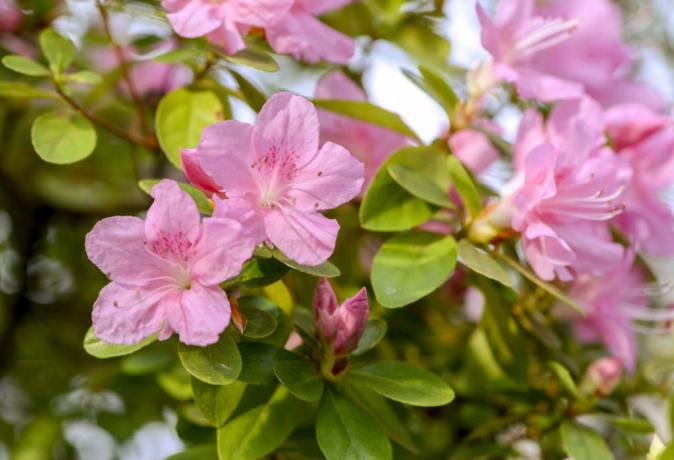
Diamond red: Large, ruby red flowers that lighten as they bloom; Growth height up to 30 cm
Elsie Lee: Double, pink flowers with red spots and wavy petal margins; Growth height up to 90 cm
Estrella: Red flowers; Growth height up to 35 cm
Azalea obt. Feenkissen ®-EU-S-: Large white flowers; Growth height up to 30 cm
Kermesina: Light red to ruby pink flowers; Growth height up to 70 cm
Königsstein: Large, purple flowers; Height up to 55 cm,
Labe: Large, pink-red flowers with a brown eye; Growth height up to 40 cm
Ledikanense: Pink flowers with red spots; Growth height up to 90 cm
Madame van Hecke: Pink flowers; Growth height up to 70 cm
obt. Peppina ®: Large, pink-violet flowers with red markings; Growth height up to 30 cm
obt. Purple pillow -S-: Ruby red flowers; Growth height up to 40 cm
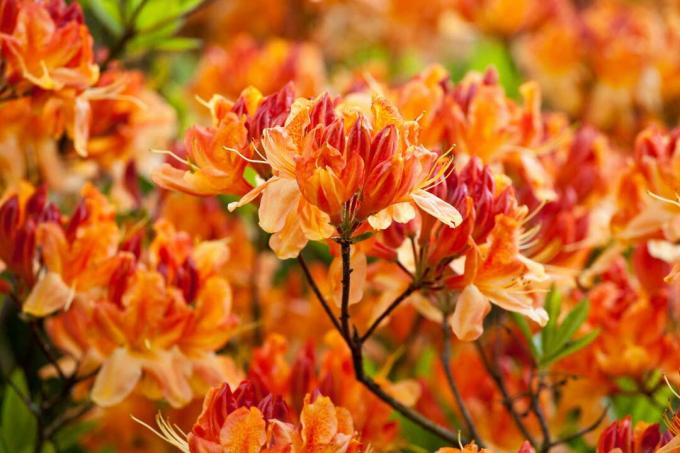
Rococo: Double, pink flowers; Growth height up to 40 cm
Snow shine: White flowers with yellow-green markings; Growth height up to 100 cm
Satschiko / Geisha Orange:Large, orange flowers; Growth height up to 45 cm
Azalea Satsuki (R. indicum): The evergreen species has small leaves and a dense, compact habit. This makes it ideal for topiary cutting and for training in bonsai. They are hardy and bloom from the beginning of May to the beginning of June, with over 1000 different varieties offering an impressive variety of colors.
Hidoshi: Pink flowers with a white-pink eye
Kegon: Pink flowers with narrow petals
Kiri-no-hikari: White-purple patterned flowers
Korin: Pink flowers with a slightly darker center
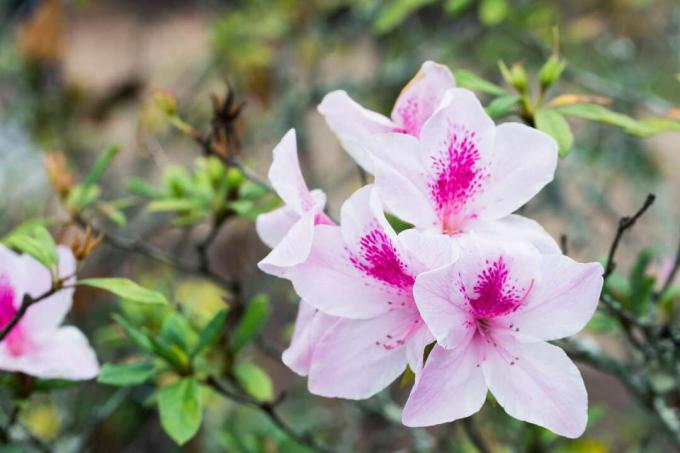
Reiko: Creamy white flowers with red flecks
Shisui: Pink flowers
Wakaebisu: Salmon-colored flowers with pink flecks
Yuki: White flowers with pink markings and speckles
Rhododendron wardii: The yellow blooming, evergreen wild form comes from China and is sufficiently hardy here. The mainly yellow to orange flowering hybrids of R. wardii grow up to three meters high.
Brasilia: Pink / yellow flowers in May to June; Growth height up to 250 cm; INKARHO
Christian: Golden yellow flowers with a warm touch of pink in May to June; Growth height up to 100 cm
Honor gold: Pink-yellow buds and light yellow flowers in May to June; Growth height up to 250 cm
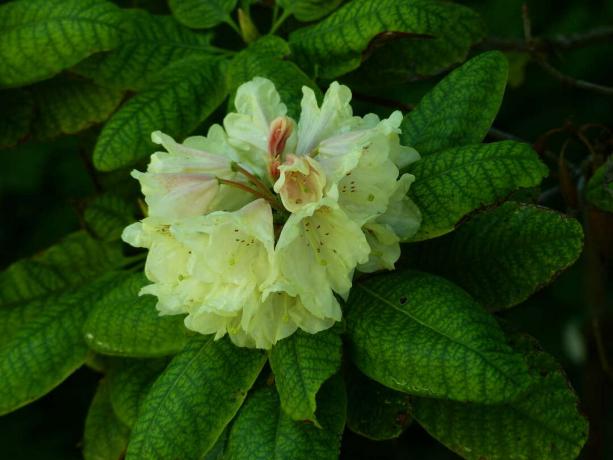
Gold bouquet: Creamy yellow flowers with red spots in May; Growth height up to 150 cm
Gold Speckles: Yellow flowers with brown spots in May; Growth height up to 80 cm
Count Lennart: Bright pale yellow flowers with red spots in May, height up to 110 cm; INKARHO
Snow level: White flowers with wine-red eyes in May; Growth height up to 150 cm
Dwarf rhododendron (R. forrestii previously repens): This species as well as its hybrids are characterized by a low, compact growth, which rarely reaches more than a meter in height. Therefore, this species is ideal for greening areas and as a ground cover. The mostly red flowers sometimes appear as early as April. These evergreen rhododendrons are relatively good to well winter hardy.
Evening glow: Growth height up to 150 cm; Blossom: End of April to May in dark scarlet red and with yellow-green buds
Baden-Baden: Growth height up to 90 cm; Flowering period: May in scarlet red with yellow-green buds
Bengal: Growth height up to 60 cm; Flowering time: May in bright red
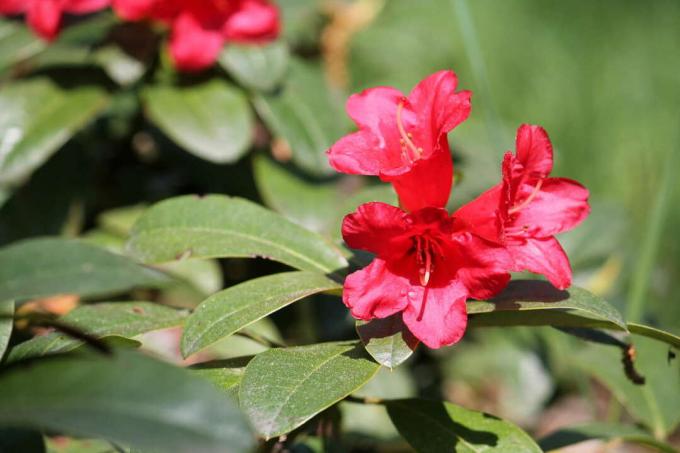
Red Carpet: Growth height up to 90 cm; Flowering period: end of April to May in fire red with brown-red buds
Scarlet Wonder: Growth height up to 60 cm; Flowering period: early to mid-May in bright red with brown-red buds
Topsi: Growth height up to 20 cm, flowering: April to May in rose-red with a wavy flower border
Reddish rhododendron (R. russatum): The species from central China is evergreen with small, dark green leaves and can grow to a height of two meters. From mid-April or May to the end of May, the mostly blue to purple, more rarely pink to white flowers appear. Unlike most species of rhododendrons, preferred R. russatum sunny locations. The species is hardy, but loses some of its foliage. Numerous small-flowered hybrids emerged from it.
Azure Cloud: Blue-purple flowers; Growth height up to 90 cm
Compactum: Blue-purple flowers; Growth height up to 40 cm
Gentian: Dark purple-blue flowers; Growth height up to 80 cm

Glacier night: Blue-violet flowers; Growth height up to 120 cm
Lauretta: Purple-blue flowers; Growth height up to 90 cm
Purple Pillow: Purple flowers; Growth height up to 60 cm
Rhododendron williamsianum : Also called the bell rhododendron. The mostly pink flowers hang down slightly due to their long flower stalks. The leaves are also something very special with their almost round shape and reddish leaf shoots. The shrub, which grows about 60 cm high, is also very hardy.
August Lamken: Pink flowers with dark pink spots in May; Growth height up to 140 cm
Garden director Glocker: Flowers in reddish pink with red buds in May; Growth height up to 110 cm
Garden Director Rieger: Creamy white flowers with reddish brown markings in May; Growth height up to 160 cm
Lisbon: Pink-red flowers with a light mid-May; Growth height up to 100 cm; INKARHO
Father Böhlje: Light purple flowers in May; Growth height up to 80 cm
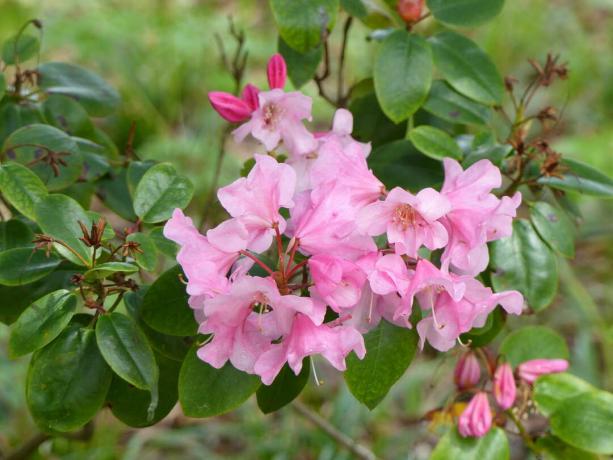
Small-leaved / dwarf rhododendron (R. impeditum): This evergreen, hardy species not only has small leaves, with a final height of around 40 cm it is also one of the lowest rhododendron species. The growth is bushy and broad. In May the dark green, spicy scented leaves disappear almost completely behind a blue to purple flower coat. The small-leaved rhododendron thrives in partially shaded and even shady locations. This makes it ideal for planting areas under higher shrubs and trees.
Bluebeard: Light blue flowers; Growth height up to 80 cm
Blumiria: Purple flowers; Growth height up to 50 cm
Moerheimii: Pastel purple flowers that show up as early as the end of April; Growth height up to 40 cm
Ramapo: Pink-purple flowers; Growth height up to 80 cm
Violetta: Purple-violet to blue flowers; Growth height up to 80 cm

Daurian rhododendron(R.dauricum): This early spring rhododendron begins to bloom occasionally in November in mild weather. The whole bloom comes to the fore from February and March until April. The flower color ranges from delicate pink to purple.
April Reign: Light pink flowers in April; Growth height up to 100 cm
April Rose: Large, bright pink flowers in March and April; Growth height up to 140 cm
Mid-winter: Purple to pink flowers; Growth height up to 1.5 meters
Praecox:Lilac-colored flowers from late March to mid-April; Growth height up to 60 cm
Staccato: Semi-double, pink flowers with a light red shade; Petals slightly curled; Growth height up to 130 cm
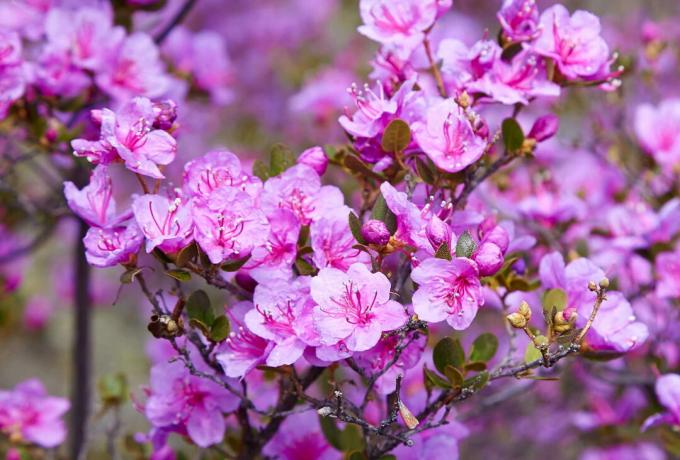
Tree rhododendron(R. arboreum): The giant among the rhododendrons grows in the wild as a tree up to 30 m high. The young shoots as well as the undersides of the leaves of this species are woolly hairy. In spring inflorescences form with up to 20 bell-shaped flowers in red to purple. In the home regions of the tree rhododendron, various mountain regions in Asia, the nectar of these flowers is used in the kitchen. In Nepal it is even the national flower. The evergreen tree loses some of its leaves in severe frost and is only partially hardy here. Just the subspecies R. arboreumspp. Delavayi is considered hardy in mild regions in sheltered places. The hybrid varieties of this species do not grow as tall as the wild form, but they produce beautifully colorful flowers.
Bibiani: Bright red flowers in September; Growth height up to 3 m
Blue Baron: Blue-violet flowers with golden-yellow markings that become lighter on the inside; Growth height up to 120 cm
Cornubia: Fire-red flowers from late February / early March
Ebony: Pink flowers with an orange-red center
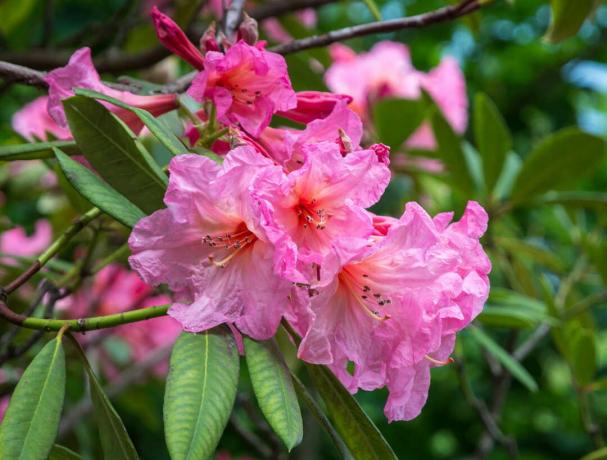
Dwarf alpine rose (Rhododendron keleticum): The dwarf alpine rose grows dense and compact, with a height of just 25 cm. It is therefore wonderfully suitable for planting areas. The flowers appear from the end of May to the beginning of June in a strong purple-violet with red markings. The edge of the petals are noticeably wavy and frayed. In winter the plants lose all of their leaves. But they are completely winter hardy.
Robert Seleger: Chimney red to light pink flowers; Growth height up to 30 cm
Indoor azaleas (Rhododendron simsii): The room azaleas have beautiful, large flowers in more or less strong pink and pink tones. In addition, they rarely grow taller than 50 cm. This coupled with the frost sensitivity of the Taiwanese exotic species makes them the ideal houseplant.
Fortunes Rhododendron (R. fortunei): This wild species is considered to be one of the most beautiful and at the same time exudes a wonderfully sweet scent when the delicate white-pink flowers appear from mid-May to mid-June. The bushy to tree-like plants are adorned all year round with long, oval leaves that slope slightly downwards. The buds are attractively scaled. The species, which comes from Asia, is only partially hardy with us.
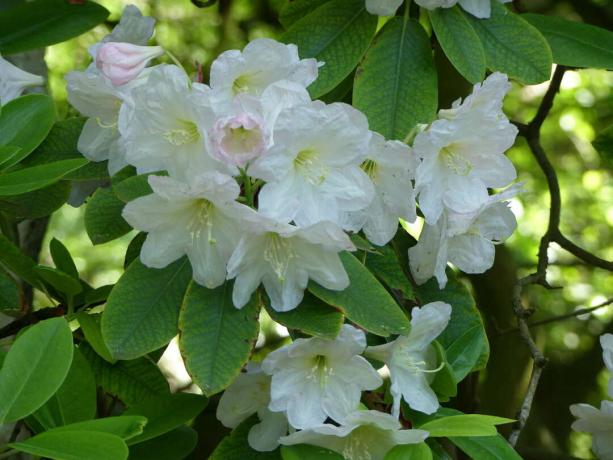
Rhododendron subgenus Hymenanthes: Tree-like varieties with a height of up to 25 m; rather unpopular in German gardens; partly hardy to -15 ° C; Flowering between January and May; mostly pink to bright red flowers.
Section Rhododendron Pentanthera: Growth form varies between tree-like and shrub-like (3 to 5 m in height); some varieties hardy to -18 ° C; Flowering period April to May; mostly single-colored, white flowers.
After this detailed list of the different rhododendron species and their varieties, you will find the 50 most beautiful ones in our special article Rhododendron varieties.
Deciduous rhododendrons: Our top 20
If you are also interested in deciduous rhododendrons, then we have put together a few popular and very ornamental deciduous varieties for you.
Rusty Dane (Rhododendron bureav): Danish variety; rust-colored underside of the leaf, slightly rust-colored, shiny upper side of the leaf; compact in growth
Grape harvest (Rhododendron smirnowii): Russian variety; double flowering period (pre-flowering in autumn, main flowering in spring); slightly tomentose growth; long, slender leaves; slightly beige
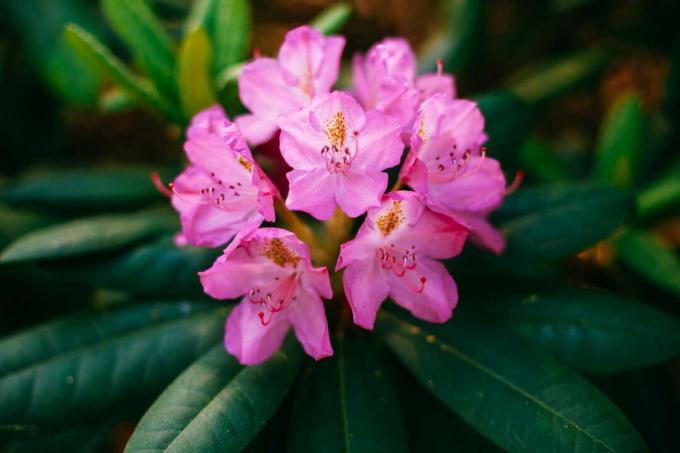
Goldflicker(Large-flowered hybrid): Flowers in June in purple-pink with yellow-brown markings; Growth height up to 140 cm; the leaves are green with a yellow center
Gold leaf(Large-flowered hybrid): Blooms in June in purple-pink with brown-yellow eye; Growth height up to 140 cm; the leaves are green with yellow markings
Carolina Spring (Large-flowered hybrid): Flowers purple-pink; Growth height up to 140 cm; the
Graziella ( ponticum): Large, pink flowers with velvet red eyes; from mid-May to early June; very narrow decorative foliage; Growth height up to 110 cm
A detailed overview of deciduous rhododendron varieties can be found here in our special article.
tip: Once the right rhododendron variety has been found, it should also be properly cared for and supplied with nutrients. A primarily organic bio-fertilizer like our Plantura Organic hydrangea fertilizer with long-term effects and an extra portion of iron is ideal for this.
INKARHO: Limestone-tolerant rhododendrons for every soil
The word "INKARHO" has its origins in the "INKAlktoleranter RHOdodendren" association. INKAHRO GmbH is an amalgamation of several tree nurseries, some of which have been breeding lime-tolerant rhododendrons for several decades. Because rhododendrons are usually so-called bog bed plants and need an acidic environment in order to be able to grow. The so-called INKARHO varieties such as Bloombux or other varieties already mentioned above are specially refined rhododendrons. Well-tried varieties, which inherently cannot cope with alkaline soils, become more tolerant of calcareous soils when they are placed on the INKARHO underlay. In addition, in most of the cultivations a much more pronounced root growth can be seen.
Rhododendron 'Bloombux':R. micranthum-Hybrid; very floriferous and easy-care variety; is traded as a boxwood alternative; Flowering time in April / May; delicate pink flowers; very strong and juicy leaves, especially in spring; evergreen
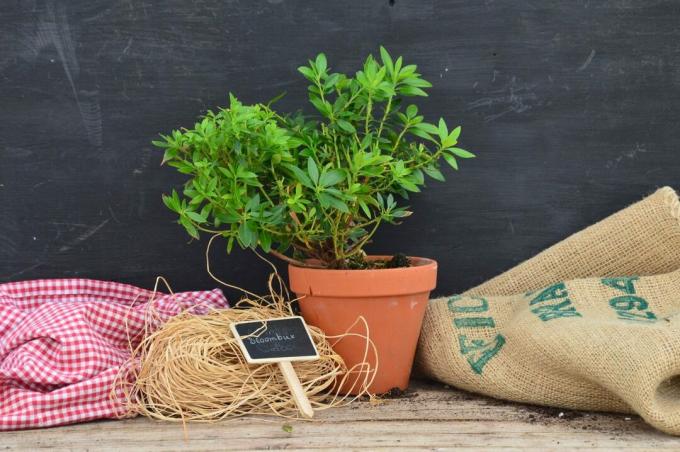
A detailed article on the Rhododendron 'Bloombux' You will find here.
Note: It is nevertheless advisable to mix in some peat or special rhododendron soil when planting so that the soil is slightly acidified. In addition, the soil life is promoted and the soil is more permeable due to the improved grain size spectrum.
If you've decided on one of these beautiful strains, that's it Plants of the rhododendron at. You can find expert tips on how to do this in this article.
